For the next five days, we will be posting about the amazing legacy of the Herreshoff family on American yacht design and construction. Today we begin with the restoration of the yacht Doris, the first yacht built to the Universal Rule, developed by Nathanael Herreshoff. Then we will review the careers of John Brown Herreshoff, the blind boatbuilder, and Nathanael Greene Herreshoff, known as the Wizard of Bristol. Next naval architect and yacht designer, Halsey Herreshoff, will explain how his grandfather, Captain Nat, carved models of his designs. We will follow by a look at Quiet Tune, a design by L. Francis Herreshoff, the son of Nathanael and the father of Halsey Herreshoff.
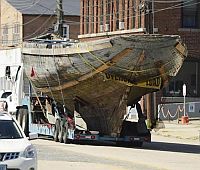
Photo: The Day/Sean D. Elliot
Drivers on Interstate 95 in Connecticut may have been surprised recently to see the 78-foot, wooden yacht Doris traveling by trailer down the highway, on her way to restoration and a new life. The 1905 built sloop is believed to be the largest surviving wooden yacht from the famous Herreshoff Manufacturing Company of Bristol, Rhode Island. Doris has been stored at Crocker’s Boat Yard in New London for the past 30 years or so, was moved to the Taylor & Snediker Yacht Restoration company of Pawcatuck. The yacht was scheduled to be scrapped at the end of August 2013, but a new, currently anonymous, owner was found. New England Boating reports that “Taylor & Snediker may employ up to 9 workers to work full time for the next 5 years on Doris. When the work is completed, most of the original frames, planking and other components will have been replaced.”
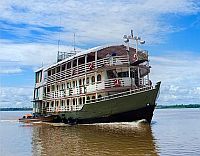 I will be out of the range of the internet for a few days, so I apologize if I am slower than usual responding to comments and emails. I will be in the Amazon Basin of Peru on the river boat, M/V La Amatista and will report back on my return.
I will be out of the range of the internet for a few days, so I apologize if I am slower than usual responding to comments and emails. I will be in the Amazon Basin of Peru on the river boat, M/V La Amatista and will report back on my return.
I happened to come across an absolutely magnificent video by Pierre Henkart. Beautiful video and editing of the Pride under sail as well as great shots of sail handling by the crew. Definitely worth the 5 minutes and 40 seconds to watch. Or even, 11 minutes 20 seconds to watch twice.
Hayley and Rob entertain belugas with a cello concert in Churchill Sound, Manitoba, Canada.
More video, after the page break.
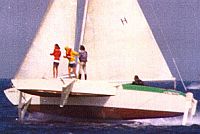
Williwaw
This summer, the French 60′ foiling trimaran Hydroptere sailed 2215 nautical miles from Los Angeles to Hawaii. The winds were not favorable and the passage was not terribly fast at about 11 days, compared to the four day record set by the 110-foot trimaran Geronimo in November 2005. Nevertheless, as most hydro-foiling sailboats are limited to relatively calm water, the ocean passage was itself an achievement. Hydroptere was not however, despite all claims, the “the first flying hydrofoil to cross an ocean.” In fact, she was not the first by almost a half century.
In the late 1960s and early 70s, an engineer named Dave Keiper designed and built the world’s first hydrofoil sailing yacht, a 32-footer named Williwaw. Keiper cruised 20,000 miles around the Pacific sailing twice to Hawaii from the West Coast and back and then on to the South Pacific as far as New Zealand in 1976. Keiper died of heart failure on June 27, 1998 at the age of 67. Keiper’s book Hydrofoil Voyager: WILLIWAW, From Dream To Reality and Toward the Sailing Yacht of the Future has recently been republished. A video of Willawaw underway:
Maersk Line has posted a 3-minute time lapse of the M/V Adrian Maersk, 6,000 TEUs, passing through the newly expanded New Suez Canal. As reported in Maritime Executive: The New Suez Canal was inaugurated by Egypt’s President Abdel Fattah Al-Sisi in a ceremony held at the port city of Ismailiya on August 6. The $8 billion project took 11 months to complete, included the widening and deepening of 35 kilometers of the existing Canal up to a depth of 24 meters, as well as digging and creating 37 kilometers of the so-called ”second lane,” running parallel to the existing Canal.
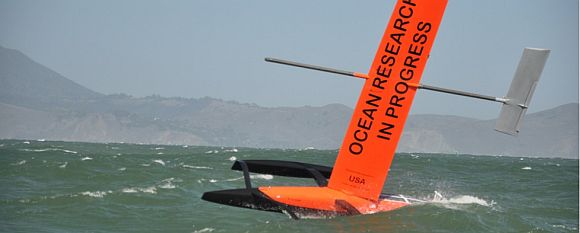 In January 2014, we posted Saildrone Sails the Pacific, about a 19′ long by 7′ wide autonomous trimaran sailing drone capable of carrying an oceanographic sensor payload of 220 pounds. In October of 2013, Saildrone-1 set off from San Francisco and arrived 34 days later in Kaneohe, Hawaii. This summer, two Saildrones have been sailing in the challenging conditions in the Bering Sea. Two drones were launched from Dutch Harbor, Alaska in the Aleutian Islands. They sailed to St. Paul, then up through the Bering Sea up to Nome, then Norton Sound, mapping the Yukon delta. Then they sailed back to Dutch Harbor, a distance of 4,500 miles. The ongoing development of Saildrones is a collaboration among researchers at NOAA’s Office of Oceanic and Atmospheric Research Pacific Marine Environmental Laboratory (PMEL), the Joint Institute for the Study of Atmosphere and Ocean (JISAO) at the University of Washington, the University of Alaska Fairbanks, and Saildrone Inc.
In January 2014, we posted Saildrone Sails the Pacific, about a 19′ long by 7′ wide autonomous trimaran sailing drone capable of carrying an oceanographic sensor payload of 220 pounds. In October of 2013, Saildrone-1 set off from San Francisco and arrived 34 days later in Kaneohe, Hawaii. This summer, two Saildrones have been sailing in the challenging conditions in the Bering Sea. Two drones were launched from Dutch Harbor, Alaska in the Aleutian Islands. They sailed to St. Paul, then up through the Bering Sea up to Nome, then Norton Sound, mapping the Yukon delta. Then they sailed back to Dutch Harbor, a distance of 4,500 miles. The ongoing development of Saildrones is a collaboration among researchers at NOAA’s Office of Oceanic and Atmospheric Research Pacific Marine Environmental Laboratory (PMEL), the Joint Institute for the Study of Atmosphere and Ocean (JISAO) at the University of Washington, the University of Alaska Fairbanks, and Saildrone Inc.
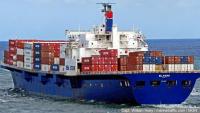 El Faro was often referred to in the media as a container ship. It is an easy mistake to make as the file photos showed her carrying stacks of containers on the main deck. El Faro, ex-Puerto Rico, ex-Northern Lights, was built as a roll-on roll-off ship in 1975 at Sun Shipbuilding. She underwent several refurbishments and as she carried containers on deck, might have been called a ro-con. Nevertheless, below decks, she was designed to carry wheeled vehicles. When she sank she was carrying 391 containers topside and 294 cars, trucks and trailers below deck. Why is this important? Tragically, it may help explain what happened to the ship and her crew.
El Faro was often referred to in the media as a container ship. It is an easy mistake to make as the file photos showed her carrying stacks of containers on the main deck. El Faro, ex-Puerto Rico, ex-Northern Lights, was built as a roll-on roll-off ship in 1975 at Sun Shipbuilding. She underwent several refurbishments and as she carried containers on deck, might have been called a ro-con. Nevertheless, below decks, she was designed to carry wheeled vehicles. When she sank she was carrying 391 containers topside and 294 cars, trucks and trailers below deck. Why is this important? Tragically, it may help explain what happened to the ship and her crew.
 In a statement this morning, the US Coast Guard says that they believe that El Faro, which disappeared last Thursday while blacked out in the path of Category 4 Hurricane Joaquin, has sunk. Coast Guard Capt. Mark Fedor said that they are now focusing on any signs of survivors. Searchers have found life rafts and survival suits, including one survival suit with human remains.
In a statement this morning, the US Coast Guard says that they believe that El Faro, which disappeared last Thursday while blacked out in the path of Category 4 Hurricane Joaquin, has sunk. Coast Guard Capt. Mark Fedor said that they are now focusing on any signs of survivors. Searchers have found life rafts and survival suits, including one survival suit with human remains.
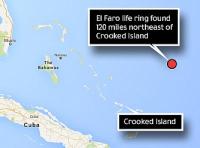 Update: From USCG Update 4 — Life jackets, life rings, containers and an oil sheen have been located by Coast Guard aircrews. The objects have not been confirmed to be from the El Faro at this time.
Update: From USCG Update 4 — Life jackets, life rings, containers and an oil sheen have been located by Coast Guard aircrews. The objects have not been confirmed to be from the El Faro at this time.
Yesterday, the US Coast Guard found a life ring from the El Faro, a ro/ro cargo ship bound from Jacksonville to Puerto Rico, which disappeared last Thursday in the path of Hurricane Joaquin. In a statement released last night, Tim Nolan, president of TOTE Maritime, the ship’s operator, said:
“Earlier today, the Coast Guard confirmed that they located a life ring floating at sea which was identified as belonging to the EL Faro. A HC130 plane spotted the ring and a H60 helicopter confirmed it was able to retrieve the ring and the ring was stenciled with markings from the El Faro.

El Faro Photo: TOTE Maritime
The US Coast Guard has resumed the search for the U.S. flagged ro/ro cargo ship, El Faro, with a crew of 33, still missing after losing power and communications in the path of Hurricane Joaquin. The 735-foot ship was bound for San Juan in Puerto Rico from Jacksonville, Florida. TOTE Maritime lost contact with the ship on Thursday at 7:20 AM EST and notified the Coast Guard. The Coast Guard reported that at approximately 7:30 AM Thursday, the Coast Guard Atlantic Area command center in Portsmouth, Virginia, received an Inmarsat satellite notification stating that El Faro was beset by Hurricane Joaquin, had lost propulsion and had a 15-degree list. The Coast Guard reported that the ship was believed to be near the worst of the Category 4 hurricane, in up to 150 mph gusts and 30-foot waves.
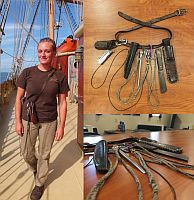 The bosun’s gear on the SSV Oliver Hazard Perry. A nice rig. My only concern would be managing the lanyards. Easy to catch on things while climbing about.
The bosun’s gear on the SSV Oliver Hazard Perry. A nice rig. My only concern would be managing the lanyards. Easy to catch on things while climbing about.
From the Oliver Hazard Perry blog: Being a full time sailor aboard any Tall Ship is a difficult job encompassing an incredible amount of knowledge and tasks. Everything from complex rigging knowledge and how to sail a square rig ship, all the way to woodworking and organization. It’s not an easy job and it goes well beyond the normal 9-5, but most sailors wouldn’t trade it for anything. Here are some of the tools carried around on a day to day basis that make sailors lives easier.
 The Clipper Round the World racer CVA24 LMAX Exchange has suffered an unexpected reversal of fortune. The LMAX Exchange crew handily won the first leg of the race from London to Rio, 100 miles ahead of its closest competitor. Now the boat is hard aground on a sandy beach 42 miles southwest of Marina da Gloria, in Rio de Janeiro. According to the Clipper Race site, CV24 LMAX Exchange was transferring to another marina to be lifted for the application of new hull branding when the incident occurred around midnight local time last night. There were no injuries.
The Clipper Round the World racer CVA24 LMAX Exchange has suffered an unexpected reversal of fortune. The LMAX Exchange crew handily won the first leg of the race from London to Rio, 100 miles ahead of its closest competitor. Now the boat is hard aground on a sandy beach 42 miles southwest of Marina da Gloria, in Rio de Janeiro. According to the Clipper Race site, CV24 LMAX Exchange was transferring to another marina to be lifted for the application of new hull branding when the incident occurred around midnight local time last night. There were no injuries.
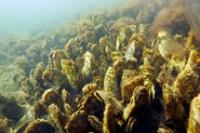 Will oysters help to clean up Chesapeake Bay and New York Harbor or will climate change take them out? The question came to mind recently when I read about the world’s largest man-made oyster reef recently finished on Harris Creek on Maryland’s Eastern Shore. The 330-acre Harris Creek reef is the first of 10 planned reefs which will be stocked with more than 1 billion oysters.
Will oysters help to clean up Chesapeake Bay and New York Harbor or will climate change take them out? The question came to mind recently when I read about the world’s largest man-made oyster reef recently finished on Harris Creek on Maryland’s Eastern Shore. The 330-acre Harris Creek reef is the first of 10 planned reefs which will be stocked with more than 1 billion oysters.
In New York City, there is a similar project, on a smaller scale but with comparable ambitions. The Billion Oyster Project’s goal is to return 1 billion oysters into the New York harbor over the next twenty years. So far they have restored 16 million, which is not a bad start. The BOP is also actively educating a new generation of students in the science and engineering of ecosystem restoration.
 We, residents of a blue marble of which 71% is covered by water, have long assumed that the rest of our solar system was relatively dry. It may be time to change that opinion. Yesterday, NASA announced strong evidence of liquid water on Mars. “Mars is not the dry, arid planet that we thought of in the past,” said Jim Green, director of planetary science at NASA Headquarters, in a press conference on Monday. Mars apparently has seasonal rivers of flowing briny water. Mars was once at least partially covered in water. “If we go back 3 billion years and take a look at Mars, Mars was a very different planet. It had what we believe was a huge ocean, perhaps as large as two-thirds of the northern hemisphere,” said Green. “But something happened. Mars suffered a major climate change and lost its surface water.”
We, residents of a blue marble of which 71% is covered by water, have long assumed that the rest of our solar system was relatively dry. It may be time to change that opinion. Yesterday, NASA announced strong evidence of liquid water on Mars. “Mars is not the dry, arid planet that we thought of in the past,” said Jim Green, director of planetary science at NASA Headquarters, in a press conference on Monday. Mars apparently has seasonal rivers of flowing briny water. Mars was once at least partially covered in water. “If we go back 3 billion years and take a look at Mars, Mars was a very different planet. It had what we believe was a huge ocean, perhaps as large as two-thirds of the northern hemisphere,” said Green. “But something happened. Mars suffered a major climate change and lost its surface water.”
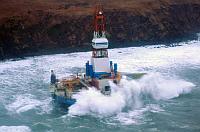 For several years, we have followed Shell Oil’s expensive, dangerous and almost farcical attempts to drill for oil in the Chukchi Sea in the Alaska’s Arctic. Shell has faced protests, multiple groundings, technical failures, and citations for safety and pollution violations. Worst of all, while Shell has spent an estimated $7 billion to get to this point, oil prices have plummeted to under $50 per barrel. Most estimates of the break even price of Arctic oil is well above $100 per barrel, that is if they find oil, which so far Shell hasn’t, at least in any quantity. Today, Royal Dutch Shell announced that it would stop exploration off the coast of Alaska “for the foreseeable future.”
For several years, we have followed Shell Oil’s expensive, dangerous and almost farcical attempts to drill for oil in the Chukchi Sea in the Alaska’s Arctic. Shell has faced protests, multiple groundings, technical failures, and citations for safety and pollution violations. Worst of all, while Shell has spent an estimated $7 billion to get to this point, oil prices have plummeted to under $50 per barrel. Most estimates of the break even price of Arctic oil is well above $100 per barrel, that is if they find oil, which so far Shell hasn’t, at least in any quantity. Today, Royal Dutch Shell announced that it would stop exploration off the coast of Alaska “for the foreseeable future.”
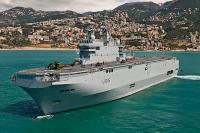 For the last five years we have followed the construction of two Mistral-class amphibious assault ships which were built in France under contract to Russia. If the wind named Mistral is said to “drive men and horses mad,” these ships may be a nautical analogue. When they were ordered by the Russians in 2010, France’s NATO allies were openly critical fo providing the ships to Russia. As reportd by the Economist: The Mistral is a mighty, 199-metre-long vessel that carries tanks and helicopters, and can conduct and manage amphibious landings. Kaarel Kaas, of the International Centre for Defence Studies, a think-tank in Tallinn, says that such ships would “transform the power balance” on Russia’s borders.
For the last five years we have followed the construction of two Mistral-class amphibious assault ships which were built in France under contract to Russia. If the wind named Mistral is said to “drive men and horses mad,” these ships may be a nautical analogue. When they were ordered by the Russians in 2010, France’s NATO allies were openly critical fo providing the ships to Russia. As reportd by the Economist: The Mistral is a mighty, 199-metre-long vessel that carries tanks and helicopters, and can conduct and manage amphibious landings. Kaarel Kaas, of the International Centre for Defence Studies, a think-tank in Tallinn, says that such ships would “transform the power balance” on Russia’s borders.
Following Russia’s annexation Crimea and support of separatists in the Ukraine, France refused to deliver the ships to ships to Russia. After tense negotiations, the French refunded $1 billion to the Russians. Now the two ships have been sold to Egypt, with “significant” financing from Saudi Arabia, for 950 million euro ($US 1.06 billion.)
T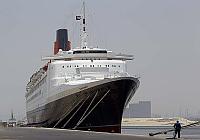 he QE2 may now be a dead ship. The MS Queen Elizabeth 2 was purchased back in 2008 for conversion to a luxury hotel in Dubai, but a worldwide recession ended those plans. Since then there are have been a variety of reports, including a more modest hotel conversion in Dubai, a luxury hotel conversation in Asia and even a scheme to bring the ship the the Thames River in London. Nothing came to fruition and last December we posted of the “Queen Elizabeth 2 Rotting Away in Dubai.”
he QE2 may now be a dead ship. The MS Queen Elizabeth 2 was purchased back in 2008 for conversion to a luxury hotel in Dubai, but a worldwide recession ended those plans. Since then there are have been a variety of reports, including a more modest hotel conversion in Dubai, a luxury hotel conversation in Asia and even a scheme to bring the ship the the Thames River in London. Nothing came to fruition and last December we posted of the “Queen Elizabeth 2 Rotting Away in Dubai.”
Now reports from Dubai say that the once proud Cunard flagship is “a floating wreck” which has been moved from her berth in Dubai Drydocks World to a holding berth in Port Rashid. It appears that the Queen Elizabeth 2 is officially dead, along with all plans for her restoration and move to an unnamed city in Asia, according to a source at Drydocks World. Thanks to Alaric Bond for passing the news along.
On Sunday, September 27th, sailors, as well as landsmen and women who happen to be looking up, will see a total lunar eclipse where the moon will turn a coppery red as it passes through the shadow of the earth. Lunar eclipses are often called “blood moons.” Because the moon is also at this closest point to earth, the moon will also appear to be just slightly larger than normal, often referred to as a “super moon.” This will be the first “Super-Blood” moon since 1982. The next lunar eclipse and super moon together will not happen again until 2033.
The partial lunar eclipse is set to begin at 9:07 p.m. ET and will be visible to most people in the Americas, Europe, Africa and the Middle East, according to EarthSky.org. (For a map of where the eclipse will be visible, click here.) The total lunar eclipse begins at 11:11 p.m. ET.
If you can’t get outside, NASA’s live stream will begin at 8 pm EDT from the Marshall Space Flight Center in Huntsville, Alabama and will also feature a live look from the Griffith Observatory in Los Angeles.
